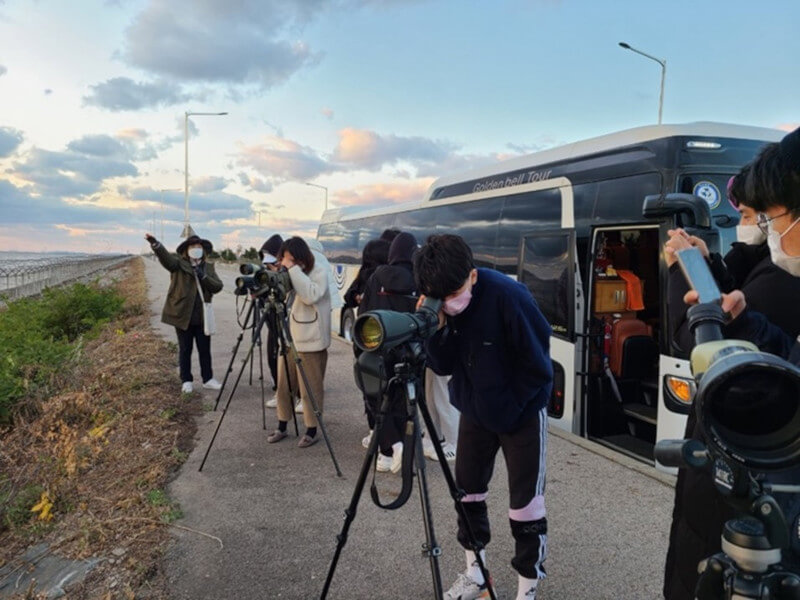
© KFEM Hwaseong
From March to May 2020, it gets busy at the Hwaseong Wetlands. During this period, flocks of shorebirds flying over the Pacific Ocean from Australia and New Zealand arrive. Along with Summer migratory waterbirds such as Black-faced Spoonbills and Egrets coming from the west coast for breeding, winter birds, including Bean Geese and ducks not yet left to the north, are spotted resting all over the mudflats and wetlands. Citizens, bird watchers, and photographers visit the Hwaseong Wetlands to watch these diverse migratory waterbirds. Over the past three years, the value of the Hwaseong Wetlands has become well understood by the experts and wetland-related NGO activists in and out of Ro Korea by holding annual International Symposiums to protect the internationally endangered species that visit the Wetlands. This was possible through tremendous work from Hwaseong City, the East Asian-Australasian Flyway Partnership (EAAFP) Secretariat, the Korean Federation for Environmental Movements (KFEM), Birds Korea, and local civil society organizations, organizing various events and promotions to conserve the Hwaseong Wetlands.
In 2020, a local project was conducted to find ways for residents, fishermen, and Hwaseong citizens along the Wetlands to recognize its importance and special value and conserve ecological excellence beyond promotion. Through local meetings, forums, campaigns, and lectures organized by KFEM Hwaseong, various views and stories of the citizens about the conservation of Hwaseong Wetlands were recorded and archived as well. ‘The future of the Hwaseong Wetlands’ was envisioned through the engagement of the fishermen and farmers living along the Wetlands, local students and urban citizens, ecotourism guides, and city council members.
#1. Local meetings and forums
Six citizen-engaging meetings and two local forums were held along with the Goon-ri Fishing Village New Deal Committee, Hwaseong Lake Fishing Community, Residents Development Council (displaced fishermen), Gyeonggi Southern Fishing Village Chief Council, Hwaseong Eco-Tour Cooperative, and Dongtan Net Cooperative. The opinions of farmers, fishermen and citizens from each meeting and regional forum provided a cornerstone for the wise conservation of the Hwaseong Wetlands.
The Hwaseong Wetlands were a mudflat formerly called the Namyang Bay, which was mostly reclaimed and became an inland area due to the project of the Hwaong District in 1991. Fishing is being continued around the Maehyang-ri Mudflats currently. Still, most fishing villages and communities have renounced fishing rather than making a living from agriculture or seeking other occupations. The Korea Rural Community Corporation (KRCC) promised to compensate and sell farmland to the displaced fishermen after the construction under the terms of consultation on the reclamation project, having them keep waiting for the promise for 30 years. The displaced fishermen who lost sea and mudflats claimed that before the Hwaseong Seawall blocked the sea, Gould’s Razor Shells and manila clams were common, and even swimming crabs were used as fertilizer. Their income was higher than that of large companies (about 50 million won/ year). Furthermore, they asserted that the KRCC should keep the promise of compensation with the farmlands. It was also suggested that the agricultural land should be made to produce food and create a form of a farming complex, but the rest of the areas of the Hwaseong Wetlands should be conserved. During the forum, a participant from Organic Farmers Korea argued, “Eco-friendly agriculture plays a leading role in focusing on biodiversity and mitigating the climate crisis. More of this is a good opportunity to increase the number of young farmers. The local economy will be revitalized if production complexes are made and connected around the farmlands.”
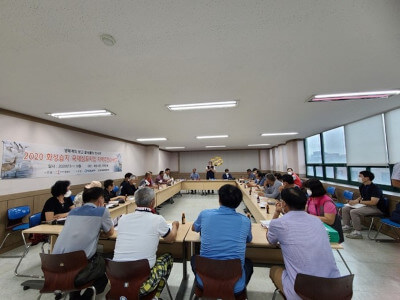 |
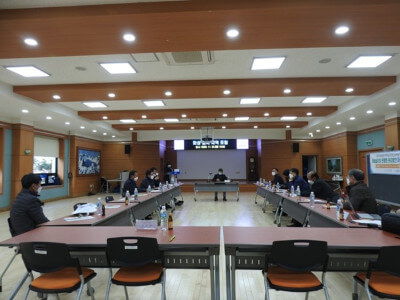 |
| Fig. 1 2020. 8. 3 Meeting with the fishermen of Council for Hwaseong Lake Development © KFEM Hwaseong | Fig. 2 2020. 11. 24 local forum on the Hwaseong Wetlands © KFEM Hwaseong |
Among the Fishing Villages of Fisheries Cooperative of South Gyeonggi Province, Hwaseong City has the largest number of fishing products and fishermen. Today, most rely on aqua culturing, while the natural sea products and the producer’s income based on those have decreased. While the fishermen agreed upon the need to protect and conserve the sea, they suggested the improvement of the facilities for leisure-based tourism, accommodations, and experiencing activities for their livelihood. Some believed the Hwaseong Seawall should be removed and the sea back again. In contrast, others argued the need for further discussion on the re-naturalization of agricultural lands that have been created already. Above all, there was a unanimous agreement on having the sea back again by enabling the overall flow of seawater at the Hwaseong Wetlands. However, a sense of misunderstanding and distrust remained about the designation of Wetland Protected Areas (WPAs), assuming that it could hinder the development of fishing, experience villages, and regional development. Through the designation of WPAs, organizing a public forum and a regional consultative body were proposed to encourage sustainable communication between residents, providing sufficient explanations and discussions regarding the incentives and support for residents.
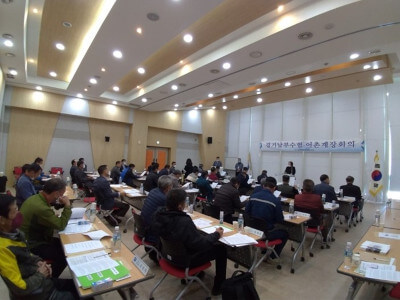 |
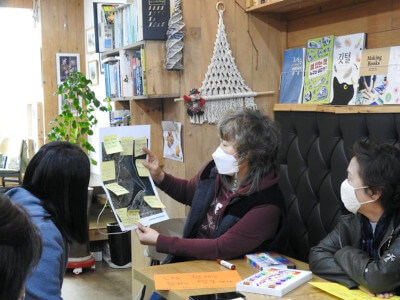 |
| Fig. 3 2020. 10. 23. Meeting with leaders from the fishing villages of the Fisheries Cooperative of South Gyeonggi Province © KFEM Hwaseong | Fig. 4 2020. 11. 12. Meeting with Dongtan Geumulko Cooperative © KFEM Hwaseong |
What thoughts and opinions do urban citizens have about the Hwaseong Wetlands? Residents from Dongtan hoped that the Hwaseong Wetlands become blue carbon storage against the climate change crisis and an ecological academic hub providing bird hides, walking trails, local festivals, and international wetland centers. Also, they suggested that it should be well-conserved for its enriched biodiversity. Once the Hwaseong Wetlands are inscribed as a Ramsar Site, it will create a sense of pride and improve the city’s value as an ecological city as a Hwaseong residence. However, there is still a concern that the Wetlands should be managed carefully not to exclude the residents.
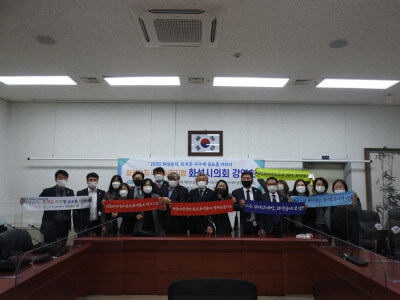
Fig. 5 2020. 11.24 The Hwaseong City Councilors holding placards for the successful organization of the Hwaseong Wetlands International Symposium© KFEM Hwaseong
#2. Students’ club activity and citizen ecological survey team
Along with 15 youth club members of Dure Natural High School and 15 members of the Dongtan Youth Environmental Club located near the Hwaseong Wetlands, education and field experience activities at the Hwaseong Wetlands were made to observe diverse species such as birds and wild animals. The benefits of the wetlands to the youth were discussed, and research on international organizations which conserve migratory waterbirds was also conducted by drawing the species that visit the Hwaseong Wetlands. By producing the video of the club’s activities and making the presentation at the International Symposium, local youths had opportunities to participate in environmental activities for wetland conservation.
 |
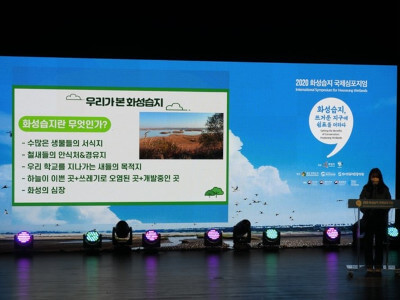 |
| Fig. 6. 2020. 11. 3. Field birdwatching from Dure Nature High School © KFEM Hwaseong | Fig. 7. 2020. 12. 1 Presenting club activities at the International Symposium © KFEM Hwaseong |
An ecological research team consisting of university students and citizens learned surveying methods for migratory waterbirds and received basic education regarding the waterbirds’ habitat environment in the Hwaseong Wetlands, which sought to develop a proper birdwatching culture by conducting research activities that involve citizens and college students based on the location. Since December, surveys on wildlife, including migratory waterbirds in Hwaseong, have been conducted, discovering Eurasian Otters (EN/class 1) and Leopard Cats (EN/class 2) with unmanned cameras. Video clips of wild animals living in the Hwaseong Lake were produced and promoted on the website and Facebook of KFEM Hwaseong.
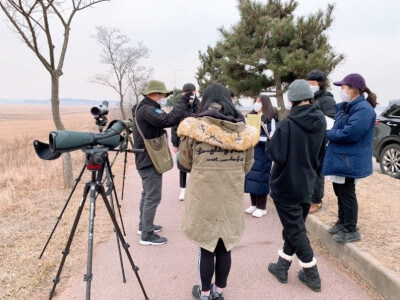
Figure 8. 2021. 3. 10. Citizen Birdwatching Team © KFEM Hwaseong
Video 1. 2021. January – March, a clip capturing wildlife along the Hwaseong Lake (unmanned camera) © KFEM Hwaseong
#3. Holding lectures and campaigns
Dr. Nial Moores from Birds Korea gave a lecture to the more than 30 guides for ecotourism and ecological education regarding the importance and ecological value of the Hwaseong Wetlands by providing an example of Far Eastern Curlew’s life cycle. Following the lecture, each group discussed and presented ten rules for tourists of the Hwaseong Wetlands and a two-day tour course program for foreign tourists. Being quiet, keeping distance from birds, and limiting the number of people were presented as rules. In addition, programs that combine culture and nature through meditating, walking, birdwatching, and local food experiences were suggested.
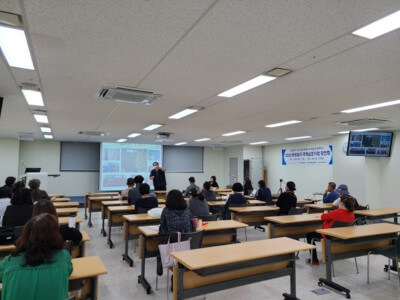
Fig. 9. 2020. 9. 24. Lecture event for the ecotour guides (Lecturer: Dr. Nial Moores, Birds Korea) © KFEM Hwaseong
Through the campaign activities to raise the awareness of the severity of marine waste problems along with the youth, students described the mudflats covered with trash, citing Charlie Chaplin’s words, “life is a tragedy when seen in close-up, but a comedy in long-shot.” Promotional materials containing the information on the designation of WPAs were distributed to residents in each village, and street campaigns were conducted towards the citizens in Bongdam and Hyangnam to introduce the Hwaseong Wetlands and receive their signatures for supporting the WPA designation process.
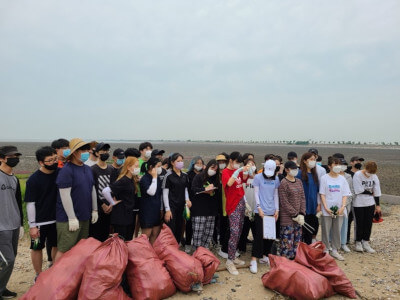
Fig. 10. 2020. 10. 6. Marine cleansing activities and campaigns © KFEM Hwaseong
There were many difficulties in holding face-to-face events due to Covid- 19 pandemic. Although the activities to meet residents and citizens were not actively carried out, sincere opinions could be shared through small-scale meetings and forums. The Hwaseong Wetlands have already lost most of the mudflats. However, with the newly created artificial wetlands, nature is giving humans another chance to protect diverse wildlife. We have experienced irreversible damage due to the reclamation project. There is a growing sense of citizenship that people can only survive by protecting nature from reckless development. The Hwaseong Wetlands is an asset to all residents, including fishermen, farmers, and citizens. Now, we are seeking ways to use and conserve the Wetlands wisely by collecting diverse opinions in the region.
The best way to conserve the internationally endangered migratory waterbird species is to foster the residents and citizens with a righteous ecological philosophy and support the process of creating an ecological culture through conserving the Hwaseong Wetlands. Hwaseong Wetlands, the great resting area of Far Eastern Curlew, will be able to protect only when activities that people and nature are continued to be connected through wetlands.
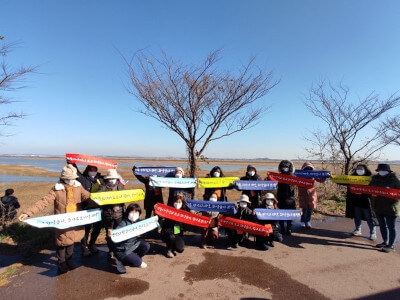 |
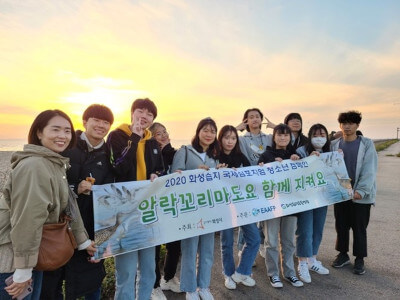 |
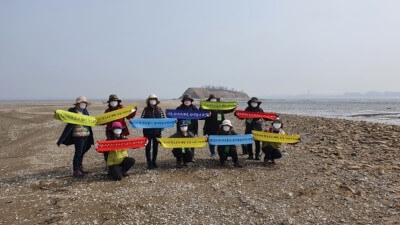 |
|
Fig. 11-1, 11-2, 11-3 . Citizens enjoying the abundant benefits provided by the Hwaseong Wetlands © KFEM Hwaseong
* The supporting project for local citizens to conserve the Hwaseong Wetlands was conducted by KFEM Hwaseong from June 2020 to March 2021 as a part of the project 「 International Symposium on the Hwaseong Wetlands and International Cooperation Project 」 hosted by the EAAFP Secretariat and Hwaseong City.
Written by Ms. Heajeong Park from KFEM Hwaseong (ehs@kfem.or.kr)
Translator: Ms. Yeonah Ku, Local Project Coordinator of EAAFP, Ms. Hyoeun Kim and
Mr. Yong June Kim, Programme Assistant of EAAFP
Korean version
지역 주민과 시민이 함께 참여했던 진솔한 현장의 이야기를 담다.
‘화성습지가 주는 풍요로운 혜택을 지속시키는 현명한 방안은?’
3월~5월, 화성습지는 매우 분주해진다. 호주와 뉴질랜드에서 출발해 태평양을 건너온 도요물떼새 무리가 하나, 둘 도착하고, 번식을 위해 서해안으로 날아온 여름철새인 저어새, 백로들과 늦장을 부리며 아직 북쪽으로 떠나지 않은 겨울철새인 큰기러기와 오리들이 갯벌과 습지를 오가며 먹고 쉬는 모습이 화성습지 곳곳에서 펼쳐진다. 그리고 다양한 새를 보기위해 시민과 탐조객, 사진사들이 화성습지 주변으로 찾아온다. 지난 3년간, 화성습지에 찾아오는 국제적 멸종위기종인 물새를 보호하고 습지를 지키기 위해 개최되었던 국제심포지엄으로 국내외 물새 전문가와 습지관련 NGO 활동가에게 화성습지의 중요성이 많이 알려졌다. 화성시와 EAAFP, 환경운동연합과 새와생명의터, 지역시민사회단체가 협력하여 화성습지를 보전하기 위한 다양한 행사와 홍보를 펼친 효과이다.
이번 2020년 국제심포지엄에서는 국내외 홍보를 넘어, 화성습지에 살고 있는 주민과 어민, 화성시민이 화성습지의 중요성과 특별한 가치에 대해 공감하고 생태적 우수성을 보전하면서 현명하게 이용하는 방안을 찾기 위한 주민참여 사업이 진행되었다. 화성환경운동연합이 주관하여 진행되었던 지역 간담회와 지역포럼, 캠페인과 강연회 등을 통해 화성습지에 대한 다양한 관점과 견해, 보전방안에 대한 시민과 주민의 이야기를 기록하고 담았다. 화성습지에서 삶을 살아가는 어민과 농민, 지역 청소년과 도시민, 생태관광 해설사, 지역 시의원 등이 참여했던 사업을 통해 화성습지의 미래를 그려보았다.
#1. 지역 간담회 및 지역 포럼
고온리어촌뉴딜위원회, 화성호어민발전협의회(간척지피해어민), 경기남부어촌계장협의회, 생태관광협동조합, 동탄그물코햡동조합 등 시민이 참여하는 간담회 6회와 지역포럼 2회를 진행하였다. 각 간담회와 지역포럼에서 나온 농민, 어민, 시민의 의견은 화성습지의 현명한 보전방안을 마련하는 토대가 되었다.
화성습지는 과거 남양만이라 불렸던 갯벌로 1991년 시작된 화옹지구 간척사업으로 대부분이 매립되어 육지가 되었다. 현재 매향리갯벌을 중심으로 어업이 지속되고 있지만 대부분의 어촌마을과 어촌계는 어업을 포기하고 농사나 취업으로 생계를 이어가고 계셨다. 한국농어촌공사가 간척사업에 대한 협의조건으로 공사가 끝나면 피해어민에게 농지보상과 분양을 약속했고 30년을 기다려왔다. 바다와 갯벌을 잃은 실어민은 과거 화성방조제로 바다가 막히기 전, 맛조개와 바지락은 흔하게 나왔고, 꽃게는 농사 비료로 사용했으며 간재미, 밴댕이, 농어 등 바다에서 버는 수입이 대기업 연봉보다 높았다며(약 5천 만 원) 농어촌공사는 어장을 잃은 실어민에게 농지보상 약속을 이행해야 한다고 주장하였다. 화성습지도 보전해야 하는 구역을 남기고 농경지를 조성해서 식량을 생산하는 농업단지를 조성해야 한다는 의견을 내주셨다. 지역포럼에 참석한 친환경농업인연합회는 ‘친환경농업은 생물의 다양성을 중심적으로 생각하고 기후위기나 막는데 선도적 역할을 하며 청년 농부를 키우는 좋은 기회가 된다. 농업뿐만 아니라 주변에 가공생산단지도 연결된다면 지역 경제가 활성화될 수 있다’고 말했다.
 |
 |
| <사진1> 2020. 8. 3 화성호어민발전협의회 간담회 | <사진2> 2020. 11. 24 화성습지 지역포럼 |
경기남부수협어촌계에서 화성지역은 수산물 생산량과 어민의 수가 가장 많다. 지금은 대부분 양식업에 의존하고 있으며 종폐나 치어를 뿌리지 않으면 바다에서 자연적으로 생산되는 수산물은 거의 없어졌으며 소득도 줄어들었다. 어민들 역시 바다를 지키고 보전해야 하는 필요성에는 공감하였으나 생계를 위해서 해양레저 관광산업이나 숙박시설, 체험시설 등 낙후된 시설개발에 대한 의견을 제시했다. 화성방조제를 없애고 다시 바다로 되돌려야 한다는 의견도 있었으나 이미 조성된 농경지에 대한 재자연화(역간척)는 충분한 논의가 필요하다는 의견이 많았다. 우선 화성호만이라도 전면적 해수유통을 통해 바다로 되살리는 부분에는 한목소리로 찬성하셨으며 습지보호지역 지정에 대해서는 어업이나 체험마을, 지역 개발에 방해가 된다는 오해와 행정에 대한 불신이 컸다. 보호지역 지정을 통해 지역 주민이 받는 혜택과 지원에 대한 설명과 토론 등 지역 주민과 지속적으로 소통하는 공론장과 지역협의체가 필요성이 제시되었다.
 |
 |
| <사진3> 2020. 10. 23. 경기남부수협어촌계장협의회 간담회 | <사진4> 2020. 11. 12. 동탄그물코협동조합 간담회 |
도시에 사는 시민은 화성습지에 대해 어떤 생각과 의견을 가지고 있을까? 동탄 주민은 화성습지가 기후위기 시대, 탄소를 흡수하는 블루카본이며 환경과 생물다양성 증진을 위해 보전되어야 하며 자연과 어울리는 탐조대, 둘레길, 산책로, 국제적 습지센터 등을 조성하고 지역 축제와 생태 교육의 장소가 되기를 희망했다. 화성시민으로 화성습지가 국제적인 람사르 습지로 등록되면 자부심도 생기고 생태도시의 가치도 높아질 것이지만 지역 주민은 소외되고 도시민의 휴양지나 관광지로 개발되지 않도록 관리되어야 한다는 의견도 제시했다.

<사진5> 2020. 11.24 화성습지 국제심포지엄 성공적 개최를 위한 화성시의회 시의원 손피켓
#2. 청소년동아리 및 시민생태조사단
화성습지 인근에 위치한 ‘두레자연고등학교’ 청소년 동아리 15명, ‘동탄청소년환경동아리’ 15명과 함께 화성습지에 대한 교육과 현장탐사를 통해 새와 야생동물 등 생물종을 관찰하는 활동을 진행하였다. 습지가 청소년에게 주는 혜택은 무엇인지 토론하고 화성습지에 오는 물새를 직접 그려보면서 물새를 보호하는 국제단체에 대한 조사도 진행하였다. 동아리에서 활동한 내용을 영상으로 제작하고 국제심포지엄에서 발표하면서 지역 청소년이 습지보전을 위한 활동에 참여하는 기회를 제공하였다.
 |
 |
| <사진6> 2020. 11. 3. 두레자연고 현장탐조 | <사진7> 2020. 12. 1 국제심포지엄에서 동아리 활동 발표 |
대학생 및 시민으로 구성된 생태조사단은 화성습지 물새 서식환경에 대한 기초 교육을 진행하고 직접 물새를 조사하는 방법을 배웠다. 지역을 중심으로 일반 시민과 대학생이 참여하는 조사활동으로 올바른 탐조문화를 만들어 나가고자 한다. 12월부터는 물새 외 화성습지 야생동물 조사를 진행하였으며 수달(멸종위기종1급)과 삵(멸종위기종 2급)의 서식을 무인카메라로 확인하였다. 화성호에 사는 야생동물을 영상으로 제작해서 화성환경운동연합 홈페이지와 페이스북을 통해 홍보하였다.

<사진8> 2021. 3. 10. 시민탐조단
<영상1> 2021. 1월~3월 화성호 야생동물 영상(무인카메라)
#3. 강연회 및 캠페인
화성습지에서 생태관광과 생태교육을 담당하는 해설사 30여 명이 참석해서 화성습지의 중요성과 생태적 가치, 알락꼬리마도요의 생애를 통한 화성습지의 역할 등에 대해 ‘새와생명의터’ 나일 무어스박사님 강연회를 진행하였다. 강연 후 각 단체별로 화성습지 관광객이 지켜야 할 10가지 규칙, 외국 관광객을 대상으로 1박2일 프로그램 만들기 등을 토론하고 발표하는 시간도 가졌다. 조용히 하기, 새와 거리두기, 인원 제한두기 등의 규칙과 사색하기, 걷기, 탐조, 지역 음식체험 등으로 문화와 자연이 결합된 프로그램을 제시하였다.

<사진9> 2020. 9. 24. 생태관광해설사 강연회 (강연자_새와생명의터 나일 무어스 박사)
캠페인활동으로 청소년과 해양 정화활동을 전개하면서 해양쓰레기의 심각함과 문제점을 홍보하였고 참가한 학생은 ‘멀리서 보면 희극, 가까이서 보면 비극’이라는 찰리 채플린의 말을 인용하여 쓰레기로 뒤덮인 갯벌을 표현하였다. 지역주민에게 습지보호지역 지정에 대한 정보를 담은 홍보물을 각 마을별로 배포하고 봉담 및 향남에서 시민을 대상으로 거리캠페인을 진행하면서 화성습지를 소개하고 습지보호지역 서명을 받는 활동도 진행하였다.

<사진10> 2020. 10. 6. 해양 정화활동 및 캠페인
코로나19로 대면행사에 많은 어려움이 있었다. 지역 주민과 시민을 만나는 활동도 적극적으로 진행하지 못했지만, 소규모로 진행된 간담회와 포럼을 통해 진솔한 의견을 나눌 수 있었다. 화성습지는 이미 대부분의 갯벌을 잃었다. 새롭게 조성된 인공습지에 자연은 인간에게 다시한번 생명을 지킬 수 있는 기회를 제공하고 있다. 우리는 간척사업으로 되돌릴 수 없는 피해를 경험했다. 무분별한 개발로부터 자연을 지켜야만 인류가 생존할 수 있다는 시민 의식이 확산되고 있다. 화성습지는 지역주민이나 어민, 농민, 시민 모두의 자산이다. 이제 지역의 다양한 의견을 모아 현명하게 이용하고 보전할 수 있는 방안을 찾고자 한다.
국제적 멸종위기종인 물새를 보전하는 가장 좋은 방법은 정의로운 생태철학을 가진 지역의 주민과 시민을 양성하고 화성습지 보전을 통한 생태문화를 만들어 나가는 과정을 지원하는 것이다. 마을과 마을이, 도시와 어촌이, 사람과 자연이 습지를 통해 연결되는 활동이 지속될 때 알락꼬리마도요의 쉼터인 화성습지를 지킬 수 있게 될 것이다.
 |
 |
 |
|
<사진 11-1, 11-2, 11-3 > 화성습지, 풍요로운 혜택을 모든 시민이 누리다!!!
* 화성습지 보전을 위한 지역주민사업은 EAAFP, 화성시가 주최하는 「화성습지 국제심포지엄 개최 및 국제협력사업」의 일환으로 2020. 6. ~ 2021. 3. 화성환경운동연합 주관으로 진행되었습니다.
화성환경운동연합 박혜정




